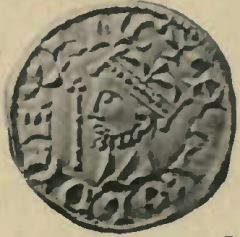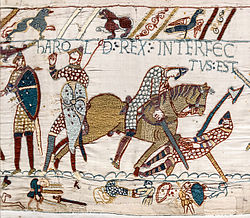Harold Godwinson
Harold Godwinson (c. 1022 – 14 October 1066) ruled England as King Harold II of England after King Edward the Confessor died. Harold ruled from 5 January 1066 until he was killed at the Battle of Hastings. His death marked the Norman conquest of England and the end of Anglo-Saxon England.
| Harold Godwinson | |||||
|---|---|---|---|---|---|
| King of England (more...) | |||||
 | |||||
| King of England | |||||
| 5 January — 14 October 1066 | |||||
| 6 January 1066 | |||||
| Predecessor | Edward the Confessor | ||||
| Successor | Edgar the Ætheling or William the Conqueror | ||||
| Born | Circa 1022 Wessex, England | ||||
| Died | 14 October 1066 (aged about 44) Battle of Hastings, Sussex | ||||
| Burial | Waltham Abbey, Essex, or Bosham (disputed) | ||||
| Spouse | Edith Swanneck Edith of Mercia | ||||
| |||||
| House | House of Godwin | ||||
| Father | Godwin, Earl of Wessex | ||||
| Mother | Gytha Thorkelsdóttir | ||||

Career
Harold was the son of Godwin, Earl of Wessex, and Gytha, a Danish noblewoman.[1] His sister, Edith, was married to the king he succeeded, Edward the Confessor.[2] About that same time, Harold became the Earl of East Anglia.[3] When his father died in 1053, Harold inherited his earldom of Wessex.[3]
Elfgar, the son of Leofric of Mercia, was appointed to replace Harold in East Anglia. Berkshire and Somerset were joined to Wessex again.[3] Wessex itself was then an enormous amount of land that covered about a third of England. Harold ruled over a large portion of England, making him the most powerful man in the whole kingdom after the king.
Harold had three brothers: Tostig,[4] Swegen[5] and Gryth.[6] He claimed to have been made King by Edward the Confessor. Before Harold became king, he swore to help William, Duke of Normandy to become king.[7]
In September 1066, Harold defeated an invasion from the north by Harald Hardrada of Norway.[6] Harold returned south to fight William's invasion[7] but was killed, it is generally assumed, by an arrow shot by one of William's archers. However, some reports stated that he was cut down by many soldiers.[8]
Harold Godwinson Media
HIC RESIDET HAROLD REX ANGLORUM. STIGANT ARCHIEP[ISCOPU]S. "Here sits Harold King of the English. Archbishop Stigand". Scene immediately after crowning of Harold by (according to the Norman tradition) Archbishop of Canterbury Stigand (d. 1072). Detail from the Bayeux Tapestry.
Harold's death depicted in the Bayeux Tapestry, reflecting the tradition that Harold was killed by an arrow in the eye. The annotation above states [Hic] Harold Rex interfectus est, "[Here] King Harold has been killed".
The spot where Harold reportedly died, which became the site of Battle Abbey in East Sussex.
Bosham Church in West Sussex: the lower three storeys of the tower are pre-conquest, the top storey Norman
13th century version of Harold's crowning, from an anonymous Life of King Edward the Confessor in Cambridge University Library.
References
- ↑ Orderic Vitalis, The Ecclesiastical History of Orderic Vitalis, Volume II, Books III And IV, ed. Marjorie Chibnall (Oxford: The Clarendon Press, 1993), p. 216
- ↑ The Chronicle of Florence of Worcester; With the Two Continuations, trans. Thomas Forester (London: Henry G. Bohn; New York: AMS Press, 1854), pp. 150-52
- ↑ 3.0 3.1 3.2 Frank Stenton, Anglo-Saxon England (Oxford University Press, 1971), p. 561–569
- ↑ "Tostig Godwinson, brother of King Harold II". www.englishmonarchs.co.uk. Retrieved 2022-01-06.
- ↑ Medievalists.net (2021-08-01). "The man who should have lost the Battle of Hastings: The Saga of Swegen Godwinson". Medievalists.net. Retrieved 2022-01-06.
- ↑ 6.0 6.1 "HAROLD". geoffboxell.tripod.com. Retrieved 2022-01-06.
- ↑ 7.0 7.1 "Harold Godwinson's succession as King of England - Edward's death and claimants to the throne - Edexcel - GCSE History Revision - Edexcel". BBC Bitesize. Retrieved 2022-01-06.
- ↑ "Shot through the eye and who's to blame? | History Today". www.historytoday.com. Retrieved 2022-01-06.





